Need guidance on marketing and keyword strategies? Learn 9 ways on how you can use Google Trends to uncover valuable insights that will help inform your SEO and marketing.
Google Trends isn’t your average keyword tool. It’s super insightful for making important marketing decisions and can be handy for anyone no matter if they are in SEO, social media, or even eCommerce.
But before we dive into the 8 ways you can use Google Trends, let’s first understand.
What is Google Trend?
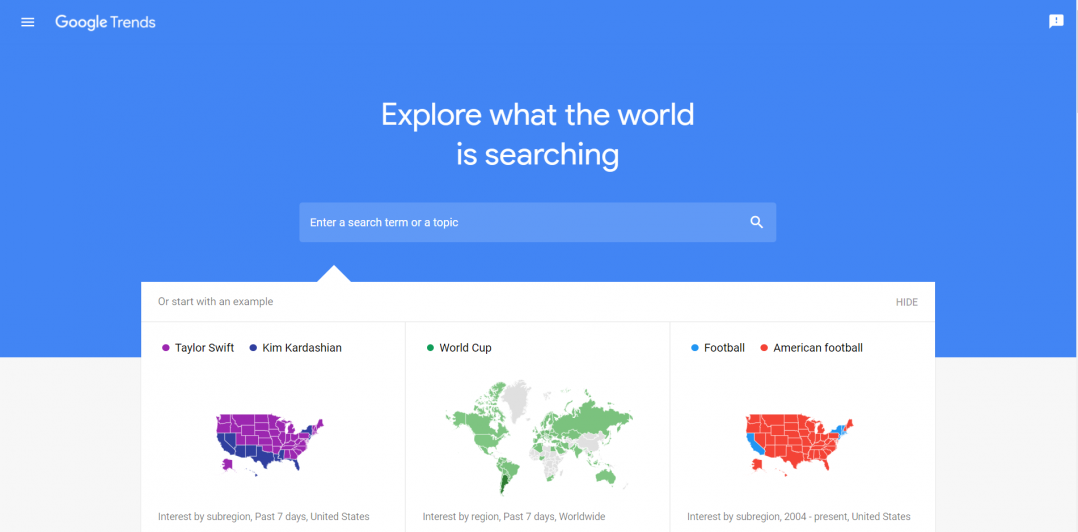
Google Trend is a search feature that helps visualize and discover trends in people’s search behavior based on the data of how frequently a given search term has been entered into Google’s search engine.
In other words, it provides you with information on which keywords are trending and allows the comparison of relative data through graphs. All this is especially good for understanding your competitor’s online presence; however, we’ll get to that in a bit.
Because first, you would need to understand Google’s Trend data.
Understanding Google Trend Data
There’s a vast amount of searches people make on Google every year, and Google Trends makes it available through using an unbiased sample of their search data.
It’s anonymized, categorized, and aggregated to allow users to measure interest in a particular topic or search term based on a certain time period and geographic location.
Absolute Keyword Volume vs Relative Popularity

When it comes to the information on Google Trends, instead of absolute search volume, Google trends measure the relative popularity of a keyword. What do we mean by relative popularity?
Google’s relative popularity measurements mean that the search-engine keyword analysis tool measures a particular keyword’s total searches. It then compares this total to the total keyword search in a specific region over a certain period.
The numbers obtained from this ratio are then scaled from between 0 to 100. This means that if we look at the search interest of Instagram from 2004 to the present, you will see that June 2019 had the highest search interest, with a value of 100.
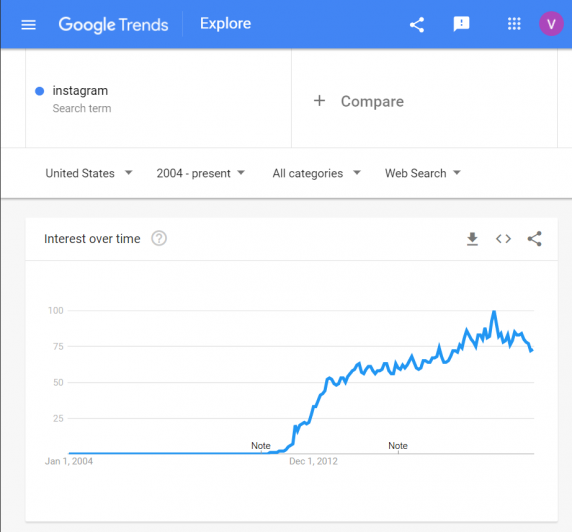
This is to make it easier for someone to compare the relative popularity between people, products, services, or things over a fixed period of time.
Hypothetical example: Calculating ‘Instagram’s’ relative popularity
For instance, let’s assume that the total number of Google searches in the US is about 10 billion a month. We could also assume that the total number of searches for the popular social media site, Instagram, is about 85 million.
To get the relative popularity ratio for ‘Instagram,’ you’ll have to divide the 80 million Instagram searches by the 10 billion total searches in the US to get 0.0085. You could set this as the basis for the first month to help you determine how much the app’s popularity has grown.
How can you use Google Trends for SEO?
Now that you know how Google Trends work. It’s time to get into how you can use it for SEO and marketing.
With Trends data, you could measure your competitor’s brand popularity, analyze the data to identify new markets, and many more. Let’s have a look at a few google trend applications in detail.

1. Use Google Trends to find trending topics
Google Trends can help you discover popular searches and trending topics that you can use for many different marketing strategies. You could use the information to improve your SEO or fine-tune your social media campaigns.
Exploring international and region-based trends
Google Trends allows you to filter your searches based on region and timeframe. These filters come in handy, especially if you are an international company and aim to ship your products or provide your services internationally.
You could also search through the platform for information on how your main keywords, for instance, your brand or your product, to see their trend pattern internationally. Using this strategy, you could get a pattern that may help you map out the best time to invest in your overseas markets and which keywords to use.
Create content about trending searches
Creating evergreen SEO content for your website can be hard sometimes. Content creators sometimes struggle to get new ideas to create the right content. Do you know what can make that a little bit easier? Google trend.
Yes, using Google Trends can keep you in the loop by providing you with inspiration for creating content ideas that most Google users are already interested in.
The only trick is finding the most relevant but trending keywords to form a basis and find a way to create an association with your brand.

Similarly, you can also discover content ideas using our BiQ’s Keyword Intelligence tool.
What helpful is our tool will provide you both the absolute search volume and the trend data when you search for your keywords.
Applying this feature helps you discover what searches are trending online and when. This may also help you come up with engaging content topics that attract a lot of readers. So give it a try, it’s free!
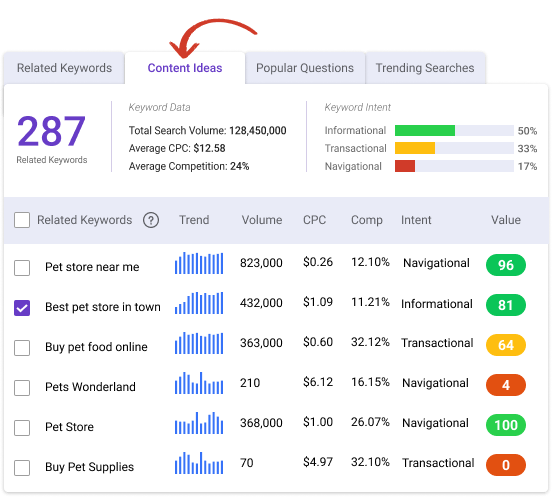
2. Use Google Trends for competitive market research
Do you ever think of yourself as James Bond, but for SEO and marketing? Well, this is what using Google Trends to ‘spy’ on your competitors and the market feels like.
Using Google Trends compare, you can identify not only market trends but also your competitors’ strengths and weaknesses, as well as analyze their products and services or their business as a whole.
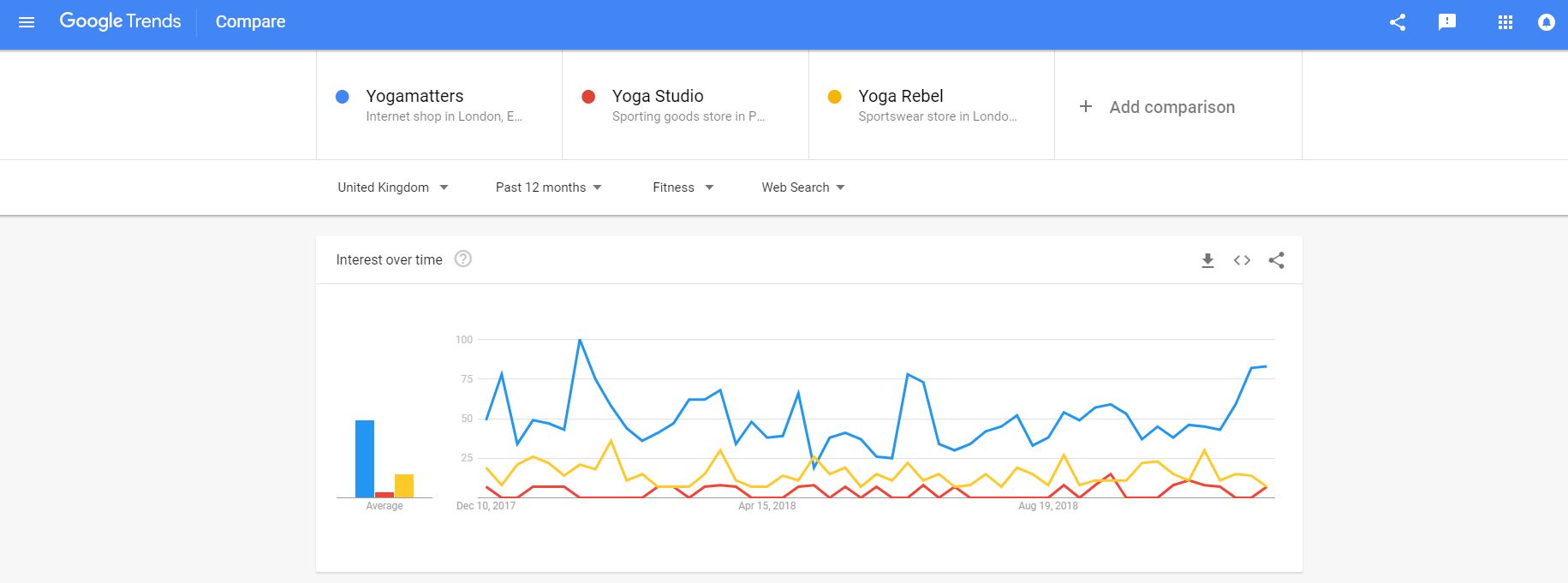
You can find out what product features your target audience wants, or you could enter your competitor’s name in the search engine and discover search queries related to their brand. Using this information, you can make improvements in your product to make it better.
If you find out, for instance, that your competing coffee brand’s customers are searching for their coffee’s nutritional benefits, you could highlight your own coffee’s dietary benefits. You could publish this information in your menu, website, or brochure for your audience to go through.
How can you use BiQ to discover your competitor’s ranking keywords?
If you want to create a website with better SEO, then keeping track and analyzing your competitors is a must. To help you with this, you can use BiQ’s Rank Intelligence to build up their keyword map and discover all the keywords that they are ranking for.
You could then make a selection of the keywords that you too have the best potential to optimize for first-page ranking and apply them in your content for better SEO.
You could also use our tool to analyze your competitor’s keyword intent to help you streamline your content to the keywords. It’s as simple as that.
3. Use Google Trends to discover skyrocketing niches
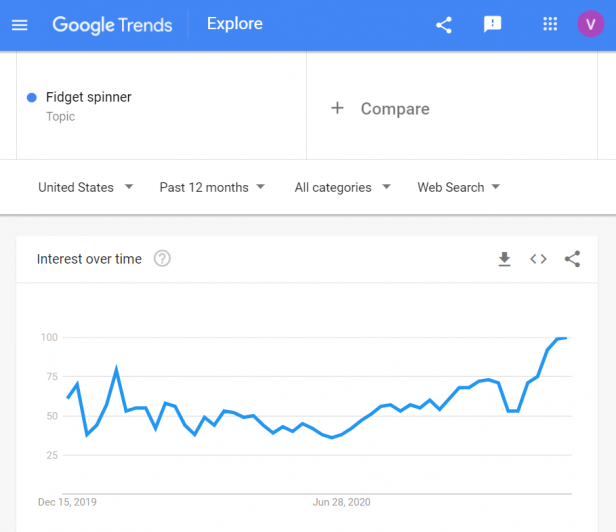
If you are in the dropshipping market or any other market that requires buyers to search for products or services directly, then Google Trends is just for you. If you set the search parameters to twelve months, you’ll be able to notice when, during the year, a product is at the highest demand.
You could also extend your search parameters to a year or two years, and it will provide you with the long-term trend for better assessment. It enables you to figure out whether the products or services’ demand has a steady increase over the years. If this is the case, then you can safely invest in it.
Google Trends is also an excellent tool in case you want to expand your business with and looking to add relevant products. into your inventory.
Let’s say you are selling men’s shoes, you could search on Google Trends for that term to get its trending pattern.
What you want to pay attention to here is also its related topics. It might display results such as men’s cycling shoes, cycling-sport, or even Dior- luxury Goods Company.
Note that some related suggestions may not be directly related to the products you sell in your store but could make sense to have them in your store.
How can you use Google Trends for keyword research?
4. Use Google Trends for related search queries
Discover related queries in the same topic
Google Trends could help you discover related queries that are in your category. Using relevant keywords from the related queries could help give you more visibility. Let’s say, for instance, that you still sell men’s shoes in your online store.
After making a search on Google Trends, you could scroll down and look at the category named related queries. Adding keywords from related queries could also help you with your visibility.
You could list specific categories in your store and name the categories with the related query headlines, i.e., dude shoes.
Since the related queries have a search volume and are relevant to the products you sell. Then adding online content targeting these queries can also help optimize your SEO for better visibility and relevance. It makes it easier for potential customers to find and go through your website.
BiQ’s Keyword Intelligence and related keywords
BiQ can also help you find related keywords that searchers are interested in. If you are not sure how to use them, our tool provides you with searcher intent that shows you why people were searching for the keyword. On top of that, you can also filter the keywords based on value.

Keywords with higher values have the potential of bringing more traffic to your website. BiQ also provides you with the total keyword search volume of all related keywords to help better gauge the topic. Similarly, you could use this information to make comparisons to help you chose the best keywords and related keywords to use.
Avoid unicorn keywords
It’s normal to find keywords with a popularity spike, such as the word “fidget spinner”. When compared to yoyo, the term fidget spinner has had more monthly searches than a yoyo. However, you may think that since fidget spinners have more inquiries than yoyo, you should use it as your keyword.
Wrong! Checking the same trend on Google Trend, you’ll discover in the past 12 months, that though the term fidget spinner had a spike towards the end of the year, there’s actually a higher interest for yo-yo throughout the year compared to fidget spinner.
In this sense, targeting yo-yo could help you could prove more reliable in the long term compared to the term fidget spinner.
5. Use Google Trends to identify seasonal trends
Using Google Trends can help you discover patterns. Looking at a particular product over five years, you may find certain peaks in the total searches consistent with specific periods in time. These are the seasonal product trends exhibited by certain products.
Think about Christmas, for instance, or thanksgiving. During this period, the overall interest scales shoots up to 100 and 50, respectively.
If you use these results with other related queries in your articles, you can be up and running before the next seasonal trend.
If you have an online store that sells Christmas merchandise, then being aware of this trend allows you to plan and market your goods in advance. This applies to both online stores and content creators. You could create specific content and publish it just before the trends spikes.
Let’s say you have great content that can’t be rewritten every other year, you could refresh it periodically with new relevant information. Ideally, you should start updating your website way before the on-peak season, so you are ready when the trending season starts.
To optimize your content, you can use BiQ’s Keyword Intelligence tool. Our tool BiQ can be relied on to analyze your content and compare it with your keyword’s top ten ranking results.
Doing this lets you know if there are any content gaps that you may have missed and if the content’s context is relevant to your audience at the time.
How can you use Google Trends for SEO?
6. Use Google Trends to understand niche topics by region

Google Trends also lets you understand the search query popularity down to the region. The results you get answer the most fundamental question in business. “Where is your product needed the most?” The more the search queries in a particular region for a product, the higher the interest by potential buyers.
How can you use this information?
Targeted ads
Using this information, you can save lots of cash that otherwise would have been wasted in ad campaigns. Instead, you can plan your ad campaigns and laser-target the specific regions that express their interest in your products or services.
Creating useful content for people in these areas
Understanding niche topics by region allows you to create personalized content for your audience in these regions. Tailor fitting your content to serve these people could significantly improve engagement and brand.
Suppose you sell heaters and search queries for heaters are concentrated around the region of Minnesota. In that case, you could come up with content specifically meant for potential buyers in Minnesota.
The title of the article could be something like this: Living in Minnesota? Here is where to get economic heater installations.
7. Use Google Trends to understand format popularity properly.
There are several different formats for content across the internet. There are video formats on YouTube, image searches, shopping, and many others. Google Trends enables you to understand search popularity for content in these different formats.
An example is when you search for HTML tutorials. While web searches for HTML tutorials have been falling, similar searches on YouTube have been steadily rising. Understanding that various formats have their levels of popularity could help you plan your content differently.
8. Use Google Trends for your YouTube content
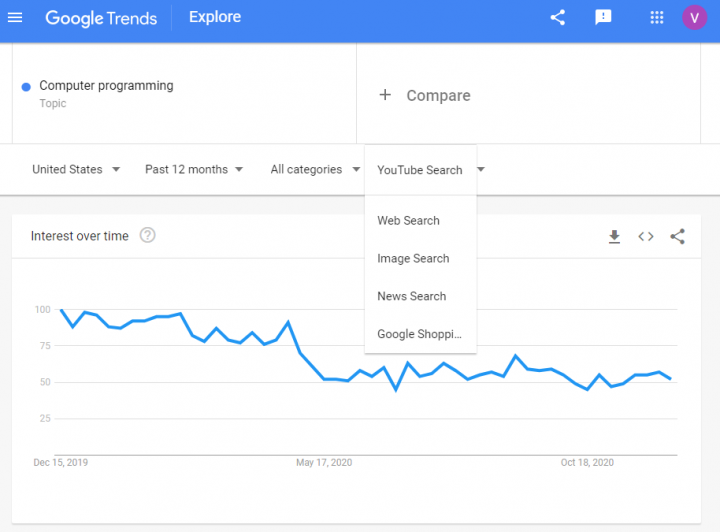
As we’ve seen earlier, search trends on the web and those on YouTube are quite different. If you want to generate interesting trending topics for your YouTube channel, you could begin by searching for the keywords and any other relevant information on Google Trends.
Your next step will be to search for the trends using the YouTube search filter. You could then make some comparisons to determine whether the topic is relevant enough to create your YouTube video content.
If you see a steady increase in the rate at which the content is trending on YouTube, you should go ahead and make your content. But it’s declining on YouTube trends but flourishing on web results; you shouldn’t waste your time on it.
Explore with Searches that Shaped the Community
Working with Google Trends may seem daunting at first; however, it is not that hard. What you need to do is have a plan. Your plan should allow you to start with the bigger picture and let you drill down into the details.
Doing this enables you to first work on the most critical part, your website’s SEO, before going down to the competitions. After all, trending content can quickly grab an audience’s attention, and let your brand raise awareness to new audiences.
Once your website gains visibility, then you can work on toppling your competitors. Keep in mind that your competitors should be your most significant learning material.
Google Trends will allow you to stay on top of the market in a dynamic e-commerce environment. Keeping in touch with the current affairs and continually updating your website with relevant information and newer, better, and more relevant keywords may be the only way to stay on top.
The best part about all this is that it is insightful to use, provides very comprehensive details, and is quite reliable in terms of its data. Out tool BiQ, on the other hand, is also quite exhaustive and detailed. Its keywords analysis algorithm is exact and produces relevant data.
Applying both of these tools to your website or YouTube channel’s content creation will help boost your SEO and focus it on the relevant audiences, which will help boost conversions. So start using Google Trends and BiQ in your keyword research today. Both are free, just sign up here!




